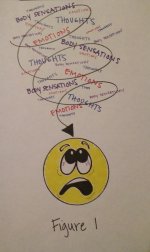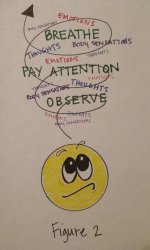David Baxter PhD
Late Founder
Getting Stuck in the Emotional Funnel
by Nancy Larsen, MSW, CSW, World of Psychology
August 18, 2018
Have you ever found yourself caught in a downward spiral of negative thoughts? It’s as if your mind is like a funnel with thoughts racing towards the bottom only to get stuck in the neck. The more you try to think your way out of the funnel the more distressed you become because there appears to be no way out.
Negative thoughts can be overwhelming, and if we are not careful, they create pathways in our mind from which we draw. Unfortunately, thoughts rarely occur without emotions. When we add emotions to our negative thoughts, we try to think our way towards a solution yet as we spiral downward, a solution seems out of reach. So much so, that we start to panic.
It may look something like this.
Picture a funnel, wide at the top, narrowing at the bottom. Consider the thought, “I feel grumpy today.” Now, put this thought into your funnel. This thought is worrisome but not distressing. However, what would happen if more worrisome thoughts followed? “I’m usually not grumpy. Maybe I’m a grumpy person. Oh…I wish this feeling would go away…”

Figure 1
We ask ourselves, “Why can’t I solve this problem? I don’t like the way this is making me feel. I wish this dreadful feeling would go away!” That’s just it! How do you wish away a feeling? It’s impossible. Emotions are like waves on the ocean. They come and go freely…unless…we take the time to notice what is happening versus why it is happening.
We do this by incorporating what Acceptance and Commitment Therapy (ACT) calls, our “observing-self.” The observing-self comes from the practice of Mindfulness and grounds us in the present moment as we are experiencing anxiety caused by uncertainty. The observing-self allows us to experience life through our senses. As we notice what is happening within us, we slow down our thought process by exploring our experience versus trying to analyze it. When we explore our emotions, we are open to our experience in a new way.
How to incorporate the observing self

Figure 2
I feel grumpy today.” I am noticing I am having the thought that I am grumpy. I feel discomfort in my stomach. Breathe in and out…again. This feeling is making me want to run away or do something else to avoid feeling it. Ok, I am going to just pay attention to this sensation and see what happens when I allow it to be there. Breath in and out slowly…Stay with the feeling…Observe it. Notice what is does. Hmm…interesting.”
As we allow ourselves to observe the possibilities of this discomfort, we avoid getting stuck in the funnel. We observe the experience by not adding to or taking away from it, thus, slowing down our thought process. We are still in the funnel as thoughts, emotions and body sensations occur, however, the way we address them leaves room for our mind to have some clarity amidst the uncertainty we are experiencing.
The next time you are experiencing discomfort, take notice of what is happening. Validate your situation and observe the experience with openness and curiosity. As you practice incorporating your observing-self, you will learn how to work through anxious moments more effectively and you will be able to spend your time doing the things you love to do with the people you love to be with. It will take some practice but soon you will begin to experience a better, stronger, more confident you.
by Nancy Larsen, MSW, CSW, World of Psychology
August 18, 2018
Have you ever found yourself caught in a downward spiral of negative thoughts? It’s as if your mind is like a funnel with thoughts racing towards the bottom only to get stuck in the neck. The more you try to think your way out of the funnel the more distressed you become because there appears to be no way out.
Negative thoughts can be overwhelming, and if we are not careful, they create pathways in our mind from which we draw. Unfortunately, thoughts rarely occur without emotions. When we add emotions to our negative thoughts, we try to think our way towards a solution yet as we spiral downward, a solution seems out of reach. So much so, that we start to panic.
It may look something like this.
Picture a funnel, wide at the top, narrowing at the bottom. Consider the thought, “I feel grumpy today.” Now, put this thought into your funnel. This thought is worrisome but not distressing. However, what would happen if more worrisome thoughts followed? “I’m usually not grumpy. Maybe I’m a grumpy person. Oh…I wish this feeling would go away…”

Figure 1
We ask ourselves, “Why can’t I solve this problem? I don’t like the way this is making me feel. I wish this dreadful feeling would go away!” That’s just it! How do you wish away a feeling? It’s impossible. Emotions are like waves on the ocean. They come and go freely…unless…we take the time to notice what is happening versus why it is happening.
We do this by incorporating what Acceptance and Commitment Therapy (ACT) calls, our “observing-self.” The observing-self comes from the practice of Mindfulness and grounds us in the present moment as we are experiencing anxiety caused by uncertainty. The observing-self allows us to experience life through our senses. As we notice what is happening within us, we slow down our thought process by exploring our experience versus trying to analyze it. When we explore our emotions, we are open to our experience in a new way.
How to incorporate the observing self
- Observe: Observe when anxious thoughts are present. Noticing thoughts is like watching a balloon as it moves along the sky. We are just watching.
- Breathe: Take a deep breath and then exhale slowly. Repeat this for one minute. Notice how your chest rises and falls as it takes in and releases air. Regulating the breath helps slow down the thought process.
- Pay attention: Pay attention to what is happening in your body. Discomfort occurs because we are experiencing more than just our thoughts. Make room for any emotions, body sensations and urges that accompany these thoughts.

Figure 2
I feel grumpy today.” I am noticing I am having the thought that I am grumpy. I feel discomfort in my stomach. Breathe in and out…again. This feeling is making me want to run away or do something else to avoid feeling it. Ok, I am going to just pay attention to this sensation and see what happens when I allow it to be there. Breath in and out slowly…Stay with the feeling…Observe it. Notice what is does. Hmm…interesting.”
As we allow ourselves to observe the possibilities of this discomfort, we avoid getting stuck in the funnel. We observe the experience by not adding to or taking away from it, thus, slowing down our thought process. We are still in the funnel as thoughts, emotions and body sensations occur, however, the way we address them leaves room for our mind to have some clarity amidst the uncertainty we are experiencing.
The next time you are experiencing discomfort, take notice of what is happening. Validate your situation and observe the experience with openness and curiosity. As you practice incorporating your observing-self, you will learn how to work through anxious moments more effectively and you will be able to spend your time doing the things you love to do with the people you love to be with. It will take some practice but soon you will begin to experience a better, stronger, more confident you.
